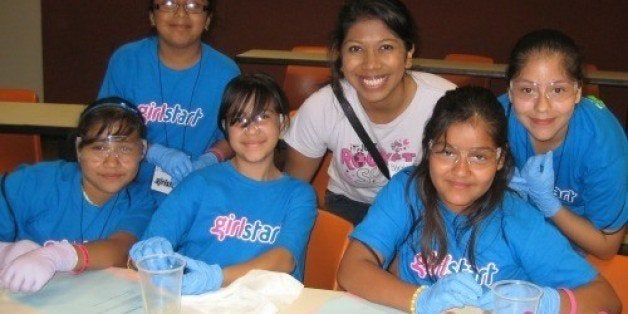
America, we can do better.
This is a mantra that inevitably gets louder every four years, but don't worry, this isn't a political commentary. This is about our country missing out on world-class talent -- and potential world-changing discoveries -- by not introducing girls to science, math, technology and math at a young age.
The state of women in STEM is dismal and, quite frankly, embarrassing: In the United States, women hold less than 25 percent of STEM jobs, according to the U.S. Department of Commerce. Around the globe, just 30 percent of the world's researchers are women. Just 3 percent of technology startups in Silicon Valley are started by women, according to a recent study by BusinessWeek.com.
That's three out of every 100 tech companies. That's just sad, especially when more than half of America's population is female.
At Girlstart, an Austin-based nonprofit that engages middle-school girls in STEM, we circle March 8 on our calendar with a big red marker. That's because it's International Women's Day -- our opportunity to reflect on the incredible successes championed by women pioneers across the globe.
March 8 is a day we can point to the accomplishments of women: It was a woman who discovered the double-helix DNA structure. It was a woman who pioneered stem cell research. And it was a woman who was the first to discover evidence of dark matter in the universe.
March 8 is a day to celebrate those feats. But I wonder what could have been discovered if we encouraged every child -- regardless of gender -- to get dirty, explore, take things apart, put them back together and -- most importantly -- make mistakes and learn from them.
In our afterschool program, I've seen firsthand the wide-eyed potential girls realize when they learn how to write computer code, fly a drone or program a simulation to cap an oil spill. It's powerful, inspiring and encouraging to show these girls another world, to teach them they can be next to walk on the moon; they can be the scientists who cure cancer; they can be part of the solution to global warming.
We're making progress, to be sure. According to Change the Equation, a national, member-based STEM advocacy group, women in 2012 were awarded nearly 20 percent of bachelor's degrees in engineering, and the same number in computer science. That's quite an improvement from 40 years earlier when women were awarded just 28 percent of the bachelor's degrees in both subjects combined, according to 2012 National Girls Collaborative Project study.
But we can do better.
To bridge that gap, we need to address gender stereotypes at a young age -- a 2011 Child Development journal study of nearly 250 Seattle-area elementary students found that even as early as second grade, boys were more likely than girls to identify their gender with math.
Girls shouldn't see any limits to their potential because of their gender. It's as simple as that.
As parents, teachers and leaders, we need to change the dialogue around girls and science. Let's encourage our girls to be brave, creative and curious by taking them to science museums, nurturing their curiosity in the world around them, engaging them in science groups and exposing them to role models. By doing so, we can help our girls realize all the options available to them.
The private sector can, and should, do its part. Businesses can provide mentoring, encourage diversity in the workplace, and support organizations that are providing STEM education to girls. Girlstart recently won the Allstate Youth Empowerment award, which carries with it a $10,000 grant that we will use to reach more girls. The award represents Allstate's commitment to empowering future generations.
There are plenty of others working on this issue. Together, we can all help America do better.